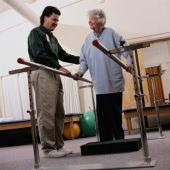
WEDNESDAY, Feb. 1 (HealthDay News) — Treating stroke patients with stem cells taken from their own bone marrow appears to safely help them regain some of their lost abilities, two small new studies suggest.
Indian researchers observed mixed results in the extent of stroke patients’ improvements, with one study showing marked gains in daily activities, such as feeding, dressing and movement, and the other study noting these improvements to be statistically insignificant. But patients seemed to safely tolerate the treatments in both experiments with no ill effects, study authors said.
“The results are encouraging to know but we need a larger, randomized study for more definitive conclusions,” said Dr. Rohit Bhatia, a professor of neurology at the All India Institute of Medical Sciences in New Delhi, and author of one of the studies. “Many questions — like timing of transplantation, type of cells, mode of transplantation, dosage [and] long-term safety — need answers before it can be taken from bench to bedside.”
The studies are scheduled to be presented Wednesday and Thursday at the American Stroke Association’s annual meeting in New Orleans.
Stem cells — unspecialized cells from bone marrow, umbilical cord blood or human embryos that can change into cells with specific functions — have been explored as potential therapies for a host of diseases and conditions, including cancer and strokes.
In one of the current studies, 120 moderately affected stroke patients ranging from 18 to 75 years old were split into two groups, with half infused intravenously with stem cells harvested from their hip bones and half serving as controls. About 73 percent of the stem cell group achieved “assisted independence” after six months, compared with 61 percent of the control group, but the difference wasn’t considered statistically significant.
In the other study, presented by Bhatia, 40 patients whose stroke occurred between three and 12 months prior were also split into two groups, with half receiving stem cells, which were dissolved in saline and infused over several hours. When compared to controls, stroke patients receiving stem cell therapy showed statistically significant improvements in feeding, dressing and mobility, according to the study. On functional MRI scans, the stem cell recipients also demonstrated an increase in brain activity in regions that control movement planning and motor function.
Neither study yielded adverse effects on patients, which could include tumor development.
But Dr. Matthew Fink, chief of the division of stroke and critical care neurology at New York-Presbyterian Hospital/Weill Cornell Medical Center, said that the therapy’s safety is the only thing the two studies seemed to demonstrate.
“The thing to keep in mind is that these are really phase one trials,” said Fink, also a professor of neurology at Weill Cornell Medical College. “I’m concerned that people get the idea that now stem cell treatment is available for stroke, and that’s not the case.”
Fink noted that the cells taken from study participants’ hip bones can only be characterized as “bone marrow aspirates” since the authors didn’t prove that actual stem cells were extracted.
“They haven’t really analyzed if they’re stem cells and what they turn into when they go into circulation,” he added. “The best way to look at this is, it’s very preliminary . . . when patients come to me to talk about it, I’m going to tell them it’s years away before we know if this is going to work.”
Studies presented at scientific conferences should be considered preliminary until published in a peer-reviewed medical journal.
More information
The U.S. National Institutes of Health has more information on stem cells.

